Welcome to This Is How We Do It, a series wherein we’ll be discussing projects both inside the home and out and explaining, you know, how we do it.
I believe a good sharp knife is the most important tool in a kitchen. In this article I’m going to explain how to select a good knife, how to keep it sharp, how to clean and maintain it, and how to use it properly.
What kind of knife should I get?
You absolutely do not need a knife block or an entire set of knives for regular everyday cooking. Instead, take that money you’d spend on a set and buy just one good knife.
A nice knife, if well maintained, will last you decades and is well worth the money. I’ve had my Shun santoku knife for 15 years and it’s still in great condition. Popular brands I’d recommend are Wusthof, Henckels, Global, and Shun.
I recommend either a Western-style chef knife or a Japanese-style santoku knife. A Western chef knife is typically heavier, its handle usually has finger grooves, the point of the knife sticks straight out and is not angled down, the curve of the blade is more rounded to allow for a more rocking style of cutting, and the blade is ground evenly on both sides to a V shape. A Japanese knife is typically lighter, its handle is often flat, the point angles down, the blade is less curved for more chopping style of cutting, and the blade is often ground offset and not even. To be able to maintain that thinner edge, Japanese knives are made of a stronger steel and often hold their sharpness a bit longer too.
Here are some chef knives I’d recommend (click through!):
And some santoku knives:
I’ve also found decent knives at Goodwill which just needed to be sharpened, so keep a look out for these brands there if you’re on a budget.
Is your knife sharp?
When a knife is sharp enough, you should be able to cut through a held-up piece of paper with very little pressure or slice through a tomato without squishing the fruit or ripping the skin. A brand new knife will be very sharp — try to remember how sharp that is so you know what your baseline should be and you’ll know when it’s dull. While this sounds counterintuitive, a sharp knife is a safer knife. It doesn’t slip, and if you combine that with good knife skills, you won’t cut yourself while preparing your meal. It also makes prep so much faster, less frustrating, and more satisfying.
Keeping your knife sharp
If you have a nice knife, you also absolutely need a decent honing steel. A honing steel doesn’t sharpen your knife, but it trues or straightens the edge of the blade. Often when a knife feels dull the very edge has curled from the pressure of use. Dragging the edge along the steel straightens that edge back up. I use my steel almost every time I cook. To use your steel, either hold it freely in your hand, or place the tip on a cutting board or cloth. Drag the full length of your knife from the base to the tip along the steel at a 15-20 degree angle, away from your hand, or down towards the cutting board. Do each side of the knife, alternating evenly several times. You should hear a high pitched ring if the angle is right.
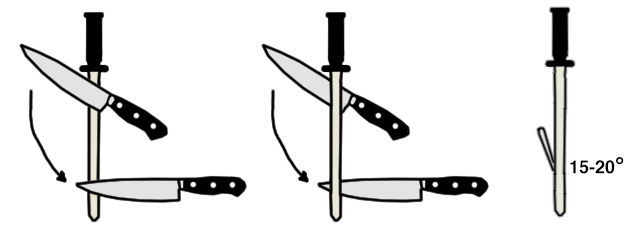
is this knife play?
Here are some steels I recommend:
If your steel isn’t cutting it anymore it’s time to take your knife to a professional sharpener. Don’t use one of those home sharpening tools that you slide the blade into. A professional sharpener will only charge you a few dollars and it will be much sharper. You should take it in at least once or twice a year, or when your knife feels dull.
Oil the handle
If your knife’s handle is wood, you’ll need to oil the handle every year or so. You can use linseed oil, danish oil, mineral oil, or even vegetable oil. Any oil is better than nothing.
Cleaning and storing your knife
If you’re feeling lazy after you’ve cooked and don’t want to clean up right away, at least clean your knife and put it away. Wash your knife in warm soapy water, dry thoroughly, and put away right after use. I use a magnetic knife strip and love how easy it is to store my knives. If you do use one, make sure your knife is really dry before putting it back so it doesn’t rust.
Do not let your knife soak in the sink, as it will rust the blade and ruin the handle (and create a potentially dangerous situation if you reach into your sink forgetting you left the knife there). Don’t ever put your knife in the dishwasher. If you have to store your knife in the drawer, get a blade protector for it, so it doesn’t get dull banging around in there.
Using your knife
If you want your knife to remain sharp, don’t cut on a dish, plate, pan, glass cutting board, or a stone counter. The only thing you should cut on is a wooden cutting board. I recommend stabilizing your board with a wet towel underneath so it doesn’t slip. Often, slippage of the cutting board is how folks cut themselves with their knives.
Hold your knife by pinching the blade with your thumb and forefinger, and curling your remaining three fingers under the handle, with your middle finger touching the back of the blade.
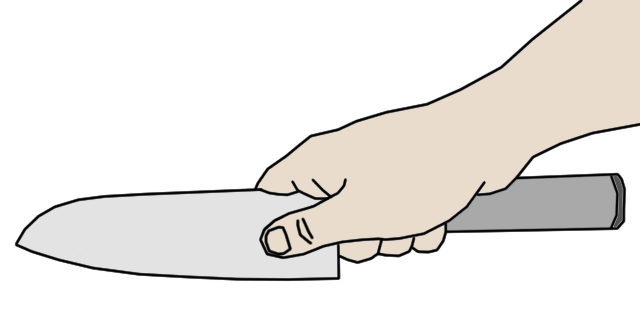
like this yay
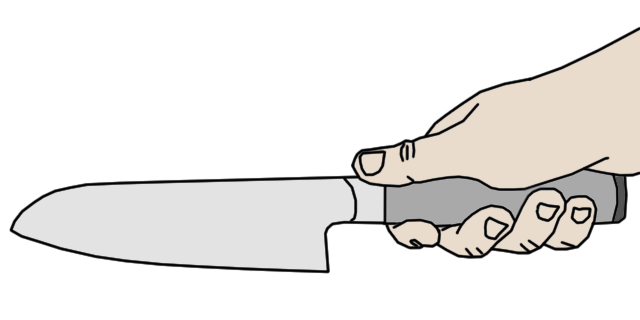
not like this boo
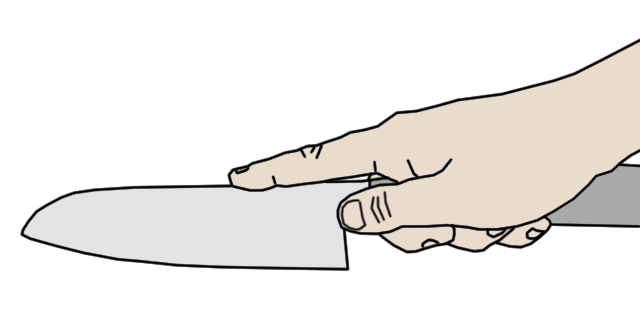
also def not like this
Use your other hand as your guide hand. Hold the food you want to cut with your in the “claw” by placing your thumb behind and curling your fingers under. This keeps your thumb and fingertips out of the way of your blade. Use your knuckles as a guide for the side of your blade. Always make sure what you’re cutting is flat side down and not a wobbly (dangerous) rounded edge. If you’re cutting something round, slice it in half first, and put the freshly cut flat sides down on the board and go from there. It’s much more stable that way, and will greatly reduce accidental slicing of your guide hand.
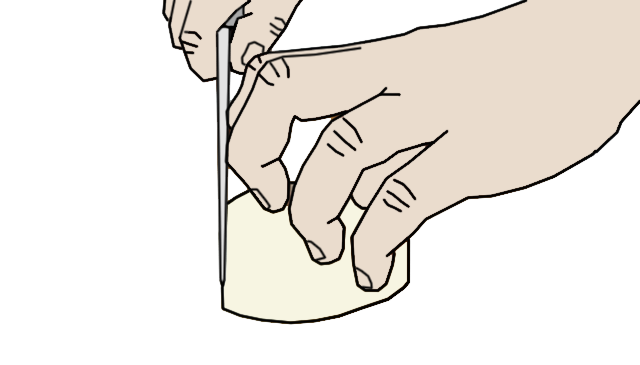
is *this* knife play?
Homework
Practice holding your knife correctly and using the claw method with your other hand. It takes a lot of time to unlearn other methods, but it’s worth the learning curve. Take it slow until you’re comfortable, then try gradually speeding up like you see cooks doing it. You may find that your dinner prep is a lot faster once you learn this method. And go get your knife sharpened professionally — it’s so worth it.



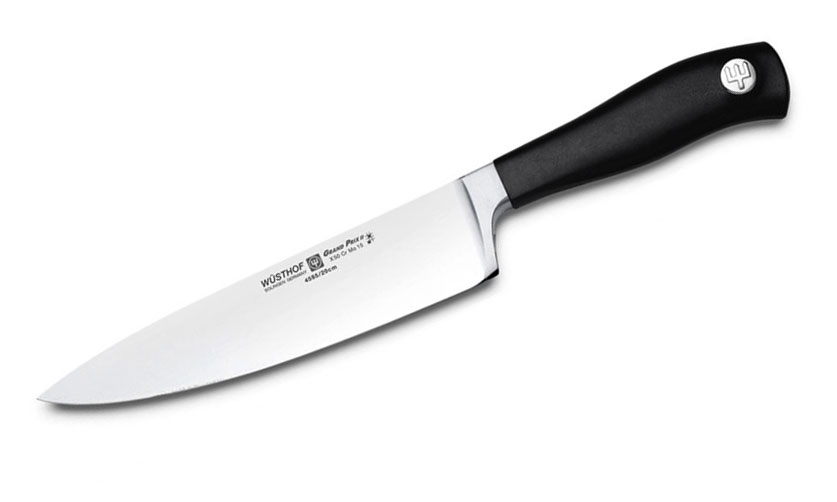

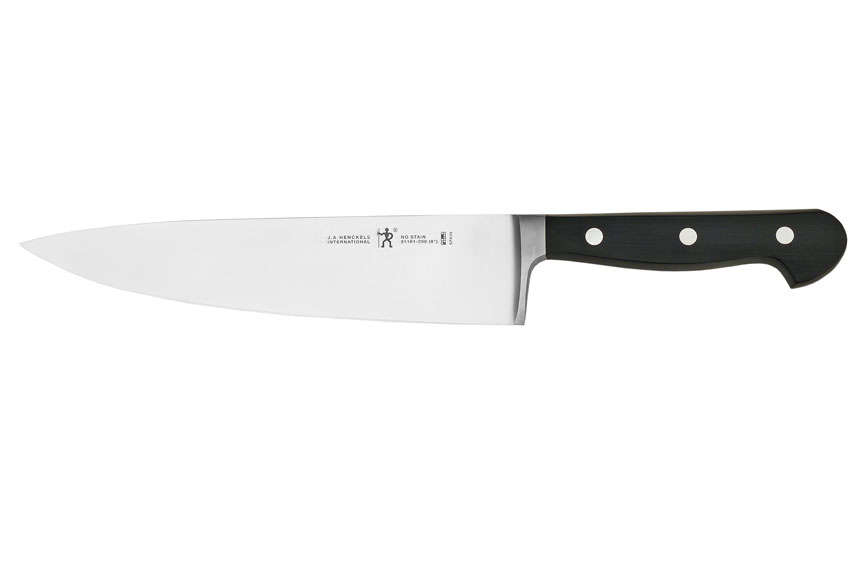



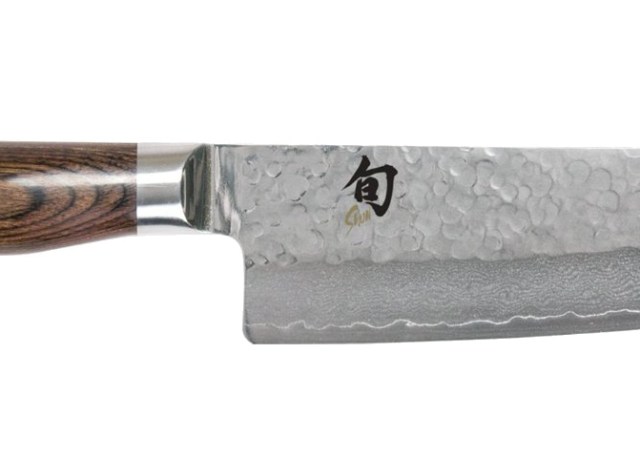

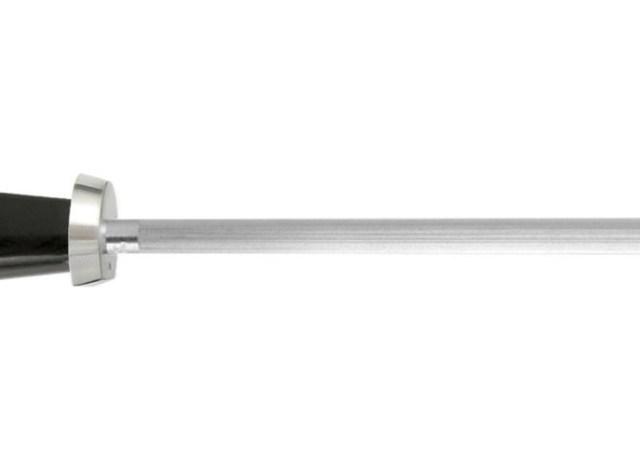

As someone that has almost severed a finger on several occasions because of poor knife sharpness and technique, I consider this the most important article for the preservation of lesbian sex ever written.
Well said Sally. Here here. I came to leave my own comment, but this is better than what I was going to write.
I got a wusthof knife for christmas a few years ago and I can honestly say it’s one of the best gifts I’ve ever received, even though I’ve been holding it wrong the entire time. But now I can practice doing it the right way from now on!
I love this article.
There is a particular joy in cutting with a good knife.
Just as there is in frying with a good pan over a decent fire.
Off to sharpen my knives!
I feel like when I get my new knife and know how to use it, I will unlock some really cool chef skills I never knew I had. Right?! That’s how this works, right?
As a former professional cook, I’m so glad to see this article! Knife skills are such an important part of being a better cook — you can work more quickly, safely, and confidently. If I may be so bold, two additions:
1. Get yourself a big-ass cutting board. I see way too many people trying to dice three onions frustratedly on a little 8×10 board. As soon as you have room to work, you’ll be amazed at how much more competent you feel. You can get a good board for a good price at discount stores.
2. If a honing steel works for you, that’s great, but personally I’m not into them — I prefer a ceramic surface to hone. You can buy a ceramic honing “steel” but really, the bottom of a plate/bowl/coffee mug is the way to go, as long as it’s not terra cotta. Googling “hone knife on plate” will result in a few tutorials, many of which wrongly say that you’re sharpening when you’re honing, but whatever. I recommend putting a damp towel underneath the plate/bowl/coffee mug — and also underneath your cutting board — to avoid slippage.
Hooray for good food prep!
Yes I agree about the size of the cutting board! I use bamboo because I find it doesn’t warp and get wobbly and I got a great one for not a lot of money at Home Goods.
The most recent love of my life in this 3-sided diamond steel so you can go from rough grit to fine grit to sharpen your knives. I always have such great and sharp tools for kitchen prep. http://www.amazon.com/Jewelstik-K123-10-Inch-Three-Sided-Sharpener/dp/B002CGS5XO
I had no idea I was doing knife skills wrong in so many ways! Great tips that I’ll definitely use!
This was fantastic! I really love cooking but I’ve never had much of a foundation in good knife skills. Thank you so much!
Yay yes awesome thank you!
I want to try the claw method.
I love chopping veggies which I attribute to learning my mom’s ability to chop them very quickly. Satisfying! If I may humbly suggest trying this out; it works best for firm veggies like carrots, celery, onions.
This method is for American-style chopping knives.
1) Put the veggie flat-side down on a big cutting board (not a small board; use one of the big thick ones).
2) Instead of holding onto the veggie, use the ‘claw’ hand (held flat, fingers + thumb pointing straight forward) on the back of the blade, towards the tip.
3) Use the hand on the back of the blade to keep the front of the knife in constant contact with the cutting board as you chop, like a pivot point.
4) Chop by raising and lowering the back of the knife by the handle as you slowly rotate in an arc over the veggie. Don’t let the front of the knife leave the board surface as you chop.
With this method you can control your chopping even while going as fast as you can, while cutting a carrot into coins as thin or thick as you like with good control.
So when I saw the title I thought this was going to be less cook-y and more…self-defensey? But the scar on my pinky finger (apparently everyone but me knew butternut squash are dangerous) would tell you I probably needed this more. Sooo thanks! Especially for the handy and clear diagrams!
Carol misandry and knife sharpening. Autostraddle has me feeling incredibly motivated right now.
Using the right tool for the job is important in many walks of life and as for kitchen knives I have a lovely crescent shaped scar along one of my fingers to attest to this.
Bread knife not good for cutting Dill Whale pickles in half, not good at all but hey I was 9 years old, it was the biggest knife and closest to a tool I was far more familiar with.
Um yeah what was I gunna say about being a non-professional about the awesomeness of professional knives like those.
Meat and pretty much every vegetable can be handled with those.
My dad is big fan of saw all the meat with a serrated knife cooked or raw but if you find yourself with boneless meat that feels too wiggly to control and you’re scared you’ll slice yourself open with one of those lovely knives, freeze that meat just lil bit and it’s magical.
I’ve cut slices so thin I could see through them with the partially frozen trick.
You can’t do this thing with a paring knife
http://lifehacker.com/cut-and-seed-a-bell-pepper-with-one-swift-motion-1675985379
One of things I love most about making veggie kabobs is the prep work just there’s some purity, a beauty to chopping veggies with good knife.
Unless you’re getting heavy into carving, butchery stuff all you really need is a paring knives, those chef knives and cutting boards.
But if you’re human who has lots of un-sliced bread loaves in your life get a bread knife. Just y’know don’t use it on giant picked vegetables.
Cuban Americans, baking hobbyists, and other people of the Po’Boy Belt are likely the only humans who have un-sliced bread loaves in their lives.
The rest of you just have toast bread you’re using to make sandwiches.
Came to read this because Cee
I love it when Cee writes things
This was excellent — thanks!
(It’s seriously like you all read my brain and know exactly what adulting tool I am currently lusting after most, and then someone writes about it. I’m starting to getting a little creeped out, tbh.)
The German ones are laser cut like everything else. The Japanese ones especially the high end I mean 350 dollars a knife are hand made by the same artisans who make samurai swords. Its all hand folded steel. So much craftmanship it’s beautiful.
This is so legit and useful in my new nesting adventures!
Did anyone else sing this title Montell Jordan style in their head?